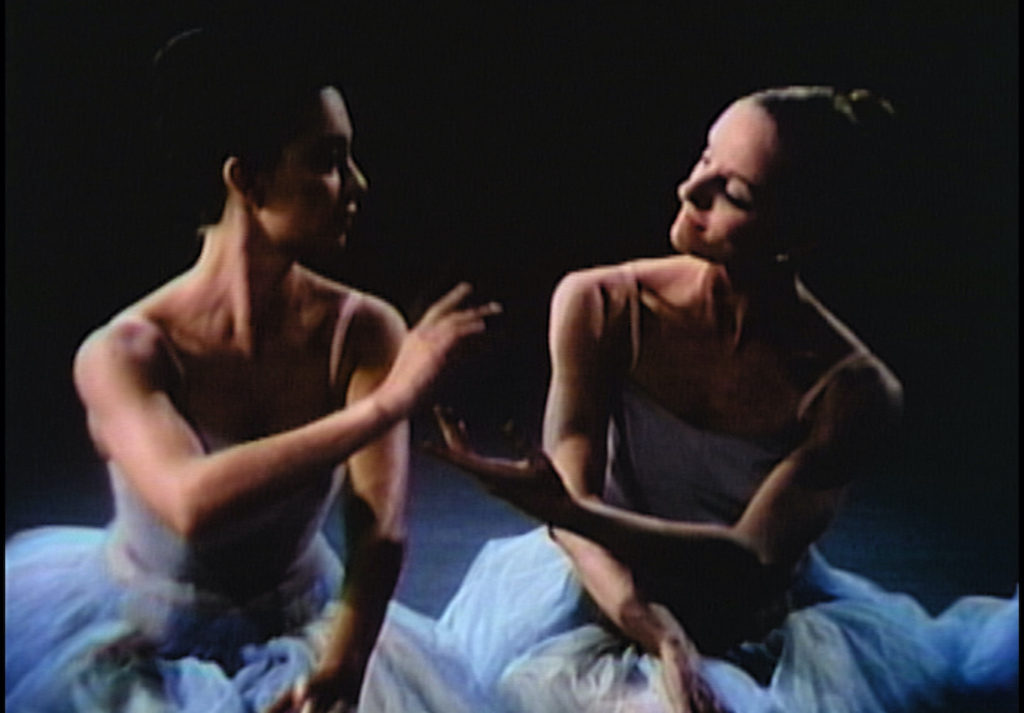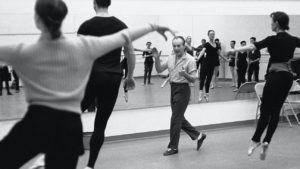In Balanchine’s Classroom: The inspirational philosopher king - Vancouver Ballet Society
- Home
- Reviews 2020 - 2023
- In Balanchine’s Classroom: The inspirational philosopher king

By Jennifer Fournier
In Balanchine’s Classroom is an intoxicating film that collects many strands of the teachings of choreographer and ballet master George Balanchine. These are shared both in his own words and in those of his former dancers, with archival photographs and footage of the artists in class, rehearsal, and performance. Directed by Connie Hochman, a former dancer with Pennsylvania Ballet, In Balanchine’s Classroom, available through Zeitgeist Films, conveys the magnitude of the Russian-born master’s contributions to ballet — not only in how he revolutionized the look of ballet, but in how he changed our understanding of the art form.
Before Balanchine, the prevailing conventions of classical ballet were, in the words of Gloria Govrin, a former Balanchine dancer and teacher, “proper and stingy.” To prove the point, we see a 1913 Russian film clip of a stagy and contrived pas de deux as Balanchine states simply in voice over, “I don’t accept the way it looks.” He found even less to like in the United States when he arrived there in 1933 at the invitation of Lincoln Kirstein, complaining about American ballet dancers with poor training, no style, and clumsy feet. He wanted dancers who were fast, clean, and precise — and his daily ballet classes at New York City Ballet (which he led from its founding in 1948 until his death in 1983) became a laboratory for exploring how far he could push his dancers to achieve this vision. As Balanchine repetiteur Joysanne Sidimus explains, “He was inventing movement that was so new, a technique to serve that choreography had not been invented.”

Many of his own dancers did not take Balanchine’s classes because they were so extreme. Govrin, one of several former New York City Ballet dancers who share their own stories of what they learned from Balanchine, reveals that many company dancers thought his classes would destroy their bodies. While a typical ballet class today might have four tendus in each position to the front, side, and back, it was not uncommon for Balanchine to make his dancers do 64 tendus in each position. Thanks to Jerome Robbins and Christine Redpath, whose foresight led them to film Balanchine’s classes, footage shows dancers in his class doing relevés and tendus at tempi that most dancers would consider impossible. Muscles that weren’t used to this much repetition and speed would cramp and burn; Govrin says she remembers thinking she would throw up.
The essential point of Balanchine’s classes was to prepare his dancers to dance his ballets better, “to set us free in that glorious repertoire,” as Heather Watts says. Balanchine revolutionized the approach to pointe work — whereas most dancers were either up on pointe or down flat, and in some schools were trained to jump straight up on to pointe, his dancers developed a much more articulate technique that used a whole range of possibilities: demi-pointe, 3/4 pointe, 7/8 pointe, and everything in between. A clip of Karin von Aroldingen in Robert Schumann’s “Davidsbündlertänze” is a stunning illustration of the gossamer effect of this pointe technique.
His classes explored movement, opposition, and also how torque could be stabilizing — for example, in the way his dancers did pirouettes from a deep low lunge. Balanchine used imagery extensively — he talked about presenting the foot like a diamond, and having hands like a baby, arms like eagle’s wings or a piece of silk — which allowed his dancers to participate in the poetry of movement. As Edward Villella says, dancers speak a physical language.

Along with perfectly crossed fifth positions, his dancers stood with their weight further forward on the foot so there was almost no weight on their heels, and as a result could move faster, plié deeper, and change direction with lightning speed. As we see in the devilish finale of Symphony in C, illustrated in archival clips of New York City Ballet in performance and in recent footage of American Ballet Theatre dancers being coached by Merrill Ashley, to dance his ballets the way they were meant to be danced you had to use his technique.
The film convincingly shows that Balanchine’s vision was about much more than technique, though. Musicality was central: he called it “the floor that we walk on.” He taught his dancers to internalize the rhythms with class exercises in which the accompanist played only the first note in every bar. He instilled the discipline of working within the architecture of time that the composer had created, taught them to count challenging scores by Stravinsky and Webern, and to play with sophisticated rhythms and jazzy counterpoint. Balanchine would never allow dancers to squeeze in another turn and finish after the music or ask the conductor to change tempi to suit their needs of the day. Watts says Balanchine told her, “It’s about your choices, not about how you feel.”
Watts is very funny in her moving account of how she struggled to fit in as a California hippie with no discipline, late for everything, with messy hair and shoe ribbons hanging out, and who didn’t really want to do class. As she began to get soloist roles, she longed to be more like ballerinas such as Suzanne Farrell, who always seemed to know what Balanchine wanted. One day she asked him directly what kind of dancer he thought she was. He replied, “You are everything and you’re nothing.” This profound appreciation for what made each dancer unique while also insisting on his dancers’ complete humility and service to the art, is one of the central paradoxes of the school of Balanchine. There were no stars (as they were traditionally understood), and yet each was like nobody else — Balanchine insisted on his way of doing things but somehow helped his dancers become more entirely themselves.
Eventually, we realize there was nothing that Balanchine’s teaching didn’t touch — his lessons were ultimately bound up with eternal things: what is right, what is good, what it means to be a particular dancer, dancing in this moment. He expected sacrifice and indeed saw it as a prerequisite for being an artist. New York City Ballet during Balanchine’s reign was not necessarily the healthiest environment — there was a lot of competition for his attention, and many dancers lost perspective as they chased his approval. This is the darker side of ballet that has been given much attention recently, and rightly so. But Balanchine might have been anticipating this critique when he said, “You would never abandon things on earth, so that’s why you don’t get anywhere. The portals are open, but the passage is narrow.”

